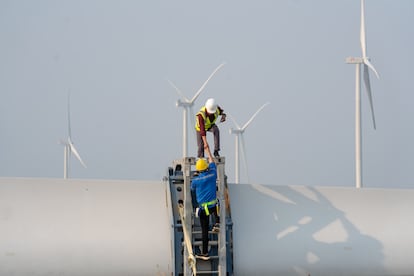The energy operation center that manages renewable sources for 24 states
Avangrid’s National Control Center in Vancouver, Washington, monitors power usage, outages, and ensures reliable delivery of electricity from renewable sources to meet the demand
When the wind gusts across the Minnesota prairies, there’s always someone in Vancouver, Washington, who knows its exact speed, direction and temperature. When rain falls on San Luis, Colorado, there’s always someone in Vancouver who knows how much and for how long. In fact, someone in Vancouver knows the current weather conditions in the wind and solar farms across the 24 states where Avangrid generates renewable energy. And they get the data in less time than it takes to read this paragraph. Accurate and timely data is vital for managing intermittency, when power generation falls short of demand. It ensures uninterrupted electricity in households, even when it’s raining on solar panels and there’s nothing to drive the wind turbines.
A team at Avangrid’s National Control Center (NCC) monitors and operates the renewable energy production facilities 24 hours a day, 365 days a year to ensure reliable delivery of emission-free electricity to 3.5 million households. Avangrid CEO Pedro Azagra likes to describe the center as an air traffic control tower for electricity transmission.

“It is a state-of-the-art 24/7 control room that acts as the nerve center for our renewables operations all over the U.S. The NCC oversees their own real time management of more than 70 wind and solar facilities supervising over 1.5 million points of data.” As the third largest onshore renewables energy generator in the U.S., this center is “critical to meet safety, reliability, resiliency, regulatory compliance and contractual obligations.”
Pedro Azagra
The center was established in 2001 and has been upgraded several times to manage a total installed capacity of 8.7 gigawatts (GW). Approximately 1.5 GW in additional capacity is under construction and will be operational soon. The United States’ first large-scale offshore wind farm in Massachusetts (Vineyard Wind 1), with a capacity of 800 megawatts (MW), will begin generating in late 2023 and will be managed from the Vancouver control center.
“Thousands of wind turbines and hundreds of inverters that convert solar panel energy into alternating current are monitored,” said Kit Blair, Senior Director of Remote Operations. “The center receives updated data from wind and solar facilities every four to eight seconds. We have a highly skilled team dedicated to turning the raw data into information the facility operators can use.”
The center quickly detects when a turbine needs repair or reconnection. Technicians, who can be thousands of miles away from the center, are then dispatched to the problem location by center operators. “We also monitor the weather very closely since it has a big impact on our operations,” said Blair. All of this is done remotely.

“We harness the renewable energy and send it to the transmission grid,” said Blair, “which means that we are constantly interacting with transmission operators, market players and customers.” Blair says transmission companies enforce strict network standards for critical aspects like voltage regulation to maintain system stability and ensure uninterrupted electricity supply.
Managing intermittent electricity supply
Blair says they are somewhat unique as a renewable operator because “we operate in an area that rebalances itself” during periods of intermittency. The country’s northwestern region has a range of electricity generation assets. Avangrid recently joined the Western Energy Imbalance Market, which is managed by the California Independent System Operator. “While the energy we generate can be transmitted elsewhere during intermittencies,” said Blair, “we also have other resources to balance supply and demand every five minutes. We can also purchase energy in this market. The best part is that it reverts back to the optimal system every five minutes.”
A key aspect of this system is that it enables renewable generation to stay operational and maximize production, even in the face of intermittent supply. “This is a crucial part of our work, especially when a significant amount of the generation relies on Mother Nature,” said Blair. “Managing intermittency requires great care to ensure consistent power supply for customers.” In other words, when you flip the switch at home, the light will go on as expected.
Avangrid’s National Control Center is full of screens, servers and data crunchers. Blair says that more renewables supplying the grid and greater digitalization have changed the way they did things 13 years ago when the center first launched. He expects even more significant changes in the future with better smart grids.

“Smart grid is an interesting term because it has multiple meanings and plays a significant role in decarbonizing the grid,” said Blair. He sees two main benefits of this technological advancement: increased energy transmission (in favorable weather conditions), and efficient renewable energy supply and demand management. For example, if someone needs to charge their electric car overnight for morning use, they can take advantage of the lower demand for electricity during the night. It’s like having a thermostat that determines the best time to use cheaper energy, making efficient use of resources.
In Avangrid’s control center, teams work in 12-hour shifts to manage renewable energy supply and demand. They first must pass a rigorous technical training program to be able to effectively use a relatively new and rapidly advancing technology. Blair says many of the technicians started out as turbine operators, and approximately a half are veterans of the U.S. Armed Forces. Blair says he enjoys telling young people about great career opportunities where every day is different and the ability to keep a cool head is an asset. Because natural emergencies — hurricanes, a polar vortex, wildfires — are to be expected.

Blair says that last July, a fire broke out near the Lund Hill solar farm in southeast Washington, leading to the activation of emergency protocols and staff evacuations. “The fire came dangerously close, prompting the fire department to ask that we shut down and secure the site. This involved disconnecting the electrical power so aerial firefighting operations could be safely conducted.”
All that was coordinated by Avangrid’s National Control Center in Vancouver, 150 miles from the fire. And when the blaze was contained, they started up the solar farm and began generating electricity again.
CREDITS
Sign up for our weekly newsletter to get more English-language news coverage from EL PAÍS USA Edition

